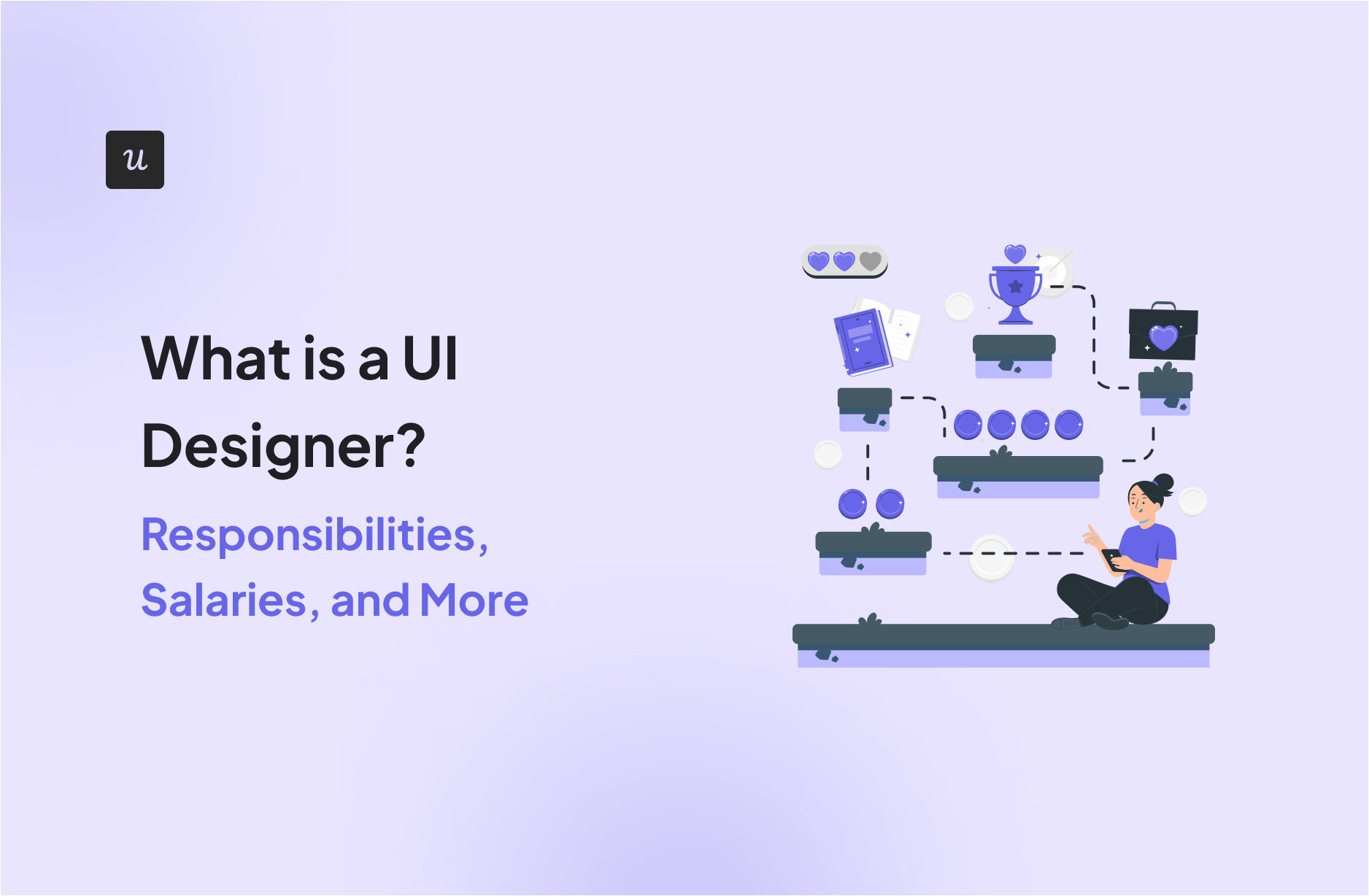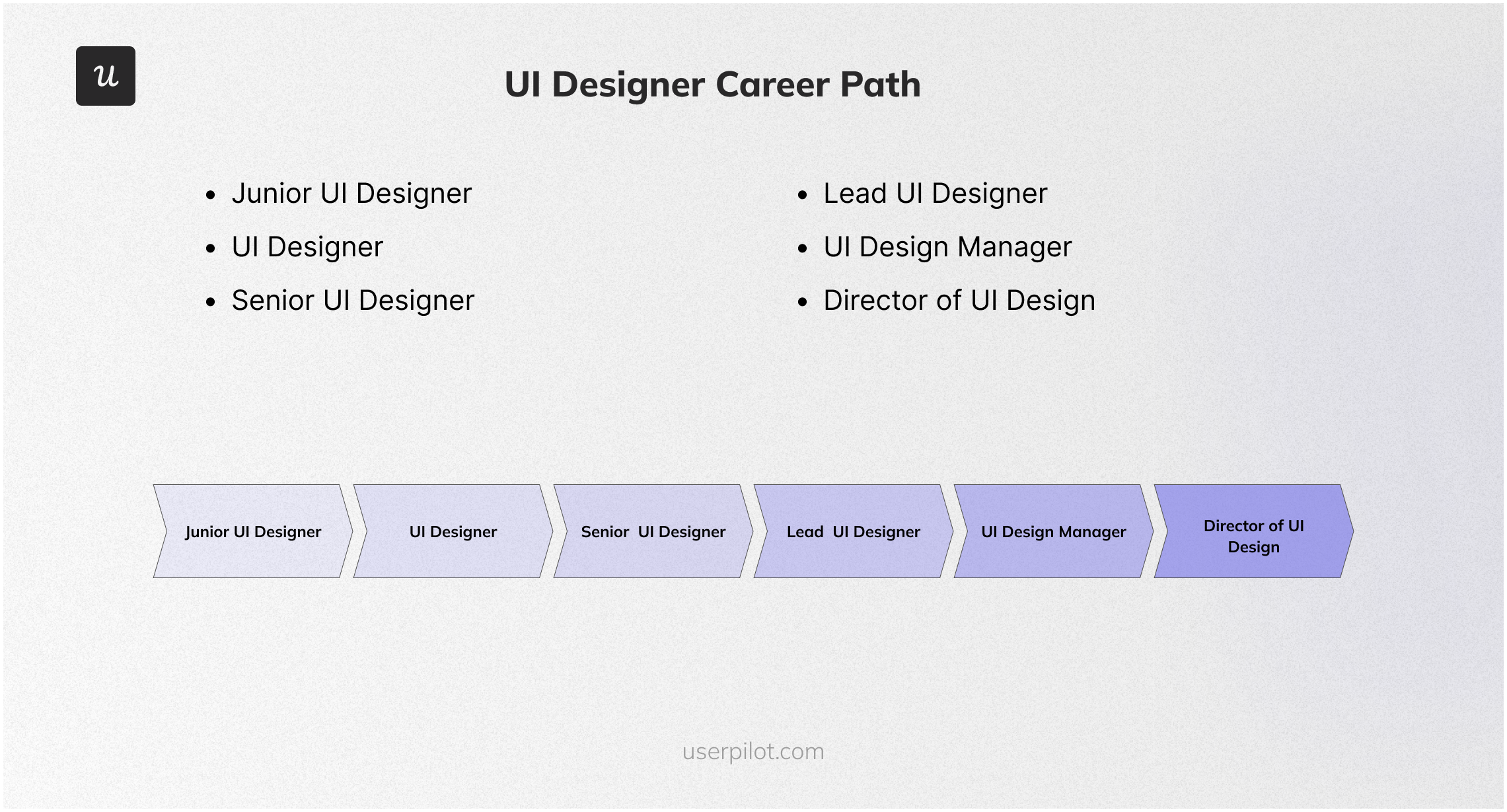
What is a UI Designer? Responsibilities, Salaries, and More5 min read
Get The Insights!
The fastest way to learn about Product Growth, Management & Trends.
What is a UI designer?
A UI (User Interface) designer focuses on creating visually appealing and interactive elements for digital products. They design the layout, visual elements, and interactive features to ensure the product is user-friendly and aesthetically pleasing.
UI designers collaborate closely with UX Designers to ensure a cohesive and engaging user experience.
What does a UI designer do?
A UI designer creates the visual aspects and interactive elements of digital products.
They design the layout, choose color schemes, select typography, and develop buttons, icons, and other graphical elements to create an intuitive and engaging interface.
UI designer’s main responsibilities
A UI designer is essential in the SaaS industry for creating intuitive and engaging user interfaces. Here are the main responsibilities and duties of a UI Designer:
- Design User Interfaces: Develop visually appealing and user-friendly interfaces.
- Create Wireframes and Prototypes: Design wireframes, mockups, and interactive prototypes.
- Collaborate with Teams: Work closely with UX designers, product managers, and developers.
- Maintain Design Systems: Create and manage design systems and style guides.
- Stay Updated with Trends: Keep abreast of the latest design trends, tools, and technologies.
- Document Design Processes: Maintain clear documentation of design processes, decisions, and guidelines.
UI designer salary
The estimated total pay for a UX designer in the United States ranges from $92,000 to $158,000 per year. This range includes both base pay and additional pay such as bonuses, commissions, tips, and profit sharing.
- Base Pay: The base salary typically ranges from $64,000 to $107,000 per year.
- Additional Pay: Additional compensation can range from $27,000 to $51,000 per year.
- Median Total Pay: The median total pay is estimated at approximately $119,592 per year, with an average base salary of $83,148 per year.
Furthermore, salaries can vary significantly depending on the company, with top companies like Cisco, Google, and Microsoft offering higher compensation packages. For example:
- Cisco: $215,675 per year
- Google: $162,598 per year
- Microsoft: $197,484 per year
Jobs in arts & design, including UX design, are growing due to increased access to remote work. These roles often require a bachelor’s degree and technical skills such as graphic design software, web development, and research. Salaries can vary widely as jobs tend to be short-term and contractual, providing flexibility and the opportunity to manage multiple projects.

UI designer career path
A career in UI design involves progressing through various roles, each with increasing responsibility and expertise. Here’s a typical career progression for a UI Designer:
- Junior UI Designer: Assists in designing interfaces, creates basic wireframes, and supports senior designers. To progress, build a strong portfolio, seek feedback, and gain practical experience through internships or entry-level positions.
- UI Designer: Conducts user research, creates wireframes and prototypes, and collaborates with cross-functional teams. To advance, take on more complex projects, refine your skills, and develop a deeper understanding of UI principles and methodologies.
- Senior UI Designer: Leads major design projects, mentors junior designers, and plays a key role in strategic planning. To progress, enhance leadership skills, contribute to creating design systems, and build strong relationships with product managers and developers.
- Lead UI Designer: Oversees the design team, ensures design consistency, and aligns design goals with business objectives. Develop project management skills, drive innovation within the team, and engage in high-level strategic planning.
- UI Design Manager: Manages the UI design team, coordinates design efforts across projects, and ensures alignment with overall business strategy. Enhance managerial skills, stay updated with industry trends, and focus on optimizing team performance and design processes.
- Director of UI Design: Sets the overall design strategy for the organization, collaborates with top executives, and ensures the design vision aligns with the company’s mission. Focus on strategic leadership, expand influence across departments, and drive the company’s design innovation.
Each step in this career path builds on the previous one, emphasizing continuous learning, leadership, and strategic thinking to progress to higher levels of responsibility and influence in the field of UI design.
Best practices for being a great UI designer
To excel as a UI designer, it’s essential to adopt practices that enhance creativity, collaboration, and user-centric design:
- Understand User Needs: Conduct user research to understand the target audience and their needs. This helps create designs that are user-centric and solve real problems.
- Stay Consistent: Use a consistent design language across the product. This ensures a cohesive and intuitive user experience.
- Iterate Based on Feedback: Embrace an iterative design process, using user feedback and testing results to continuously refine and improve designs.
- Collaborate with Team Members: Work closely with UX designers, developers, and product managers to ensure design solutions align with business goals and technical constraints.
- Keep Learning: Stay updated with the latest design trends, tools, and technologies. Continuous learning brings fresh ideas and innovations to your projects.
UI designer FAQs
- What is UI vs UX? UI (User Interface) design focuses on the visual aspects and interactive elements of a digital product, while UX (User Experience) design involves the overall experience and usability of the product. UI is about how things look, and UX is about how things work.
- Is UI design a high-paying career? Yes, it can be, especially with experience and in tech hubs. Salaries vary based on location, experience, and industry.
- Should I learn UI or UX? It depends on your interests. If you enjoy visual design and aesthetics, UI might be for you. If you prefer research, user behavior, and overall experience, consider UX.
- Is UI/UX front-end? UI/UX design is related to front-end development but focuses more on design and user experience rather than coding. Understanding front-end technologies can be beneficial.
- Do UI designers need a degree? While not always required, a degree in design, graphic design, or a related field can be advantageous. Relevant experience and a strong portfolio are often more critical.
Conclusion
We hope this guide has provided you with valuable insights into the roles, responsibilities, and rewards associated with this role.
Looking into tools for UI designers? Userpilot is an all-in-one product platform with engagement features and powerful analytics capabilities. Book a demo to see it in action!









